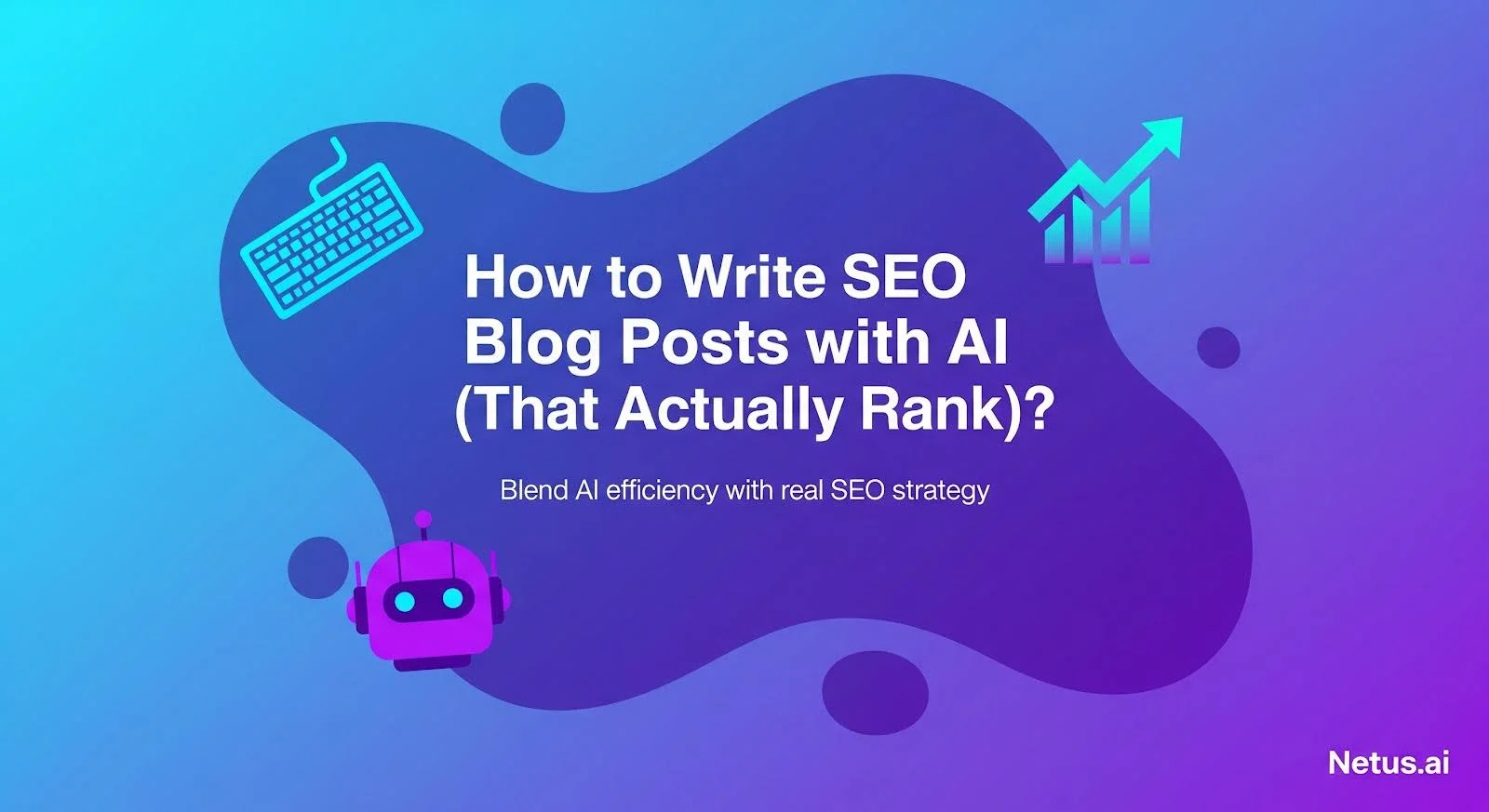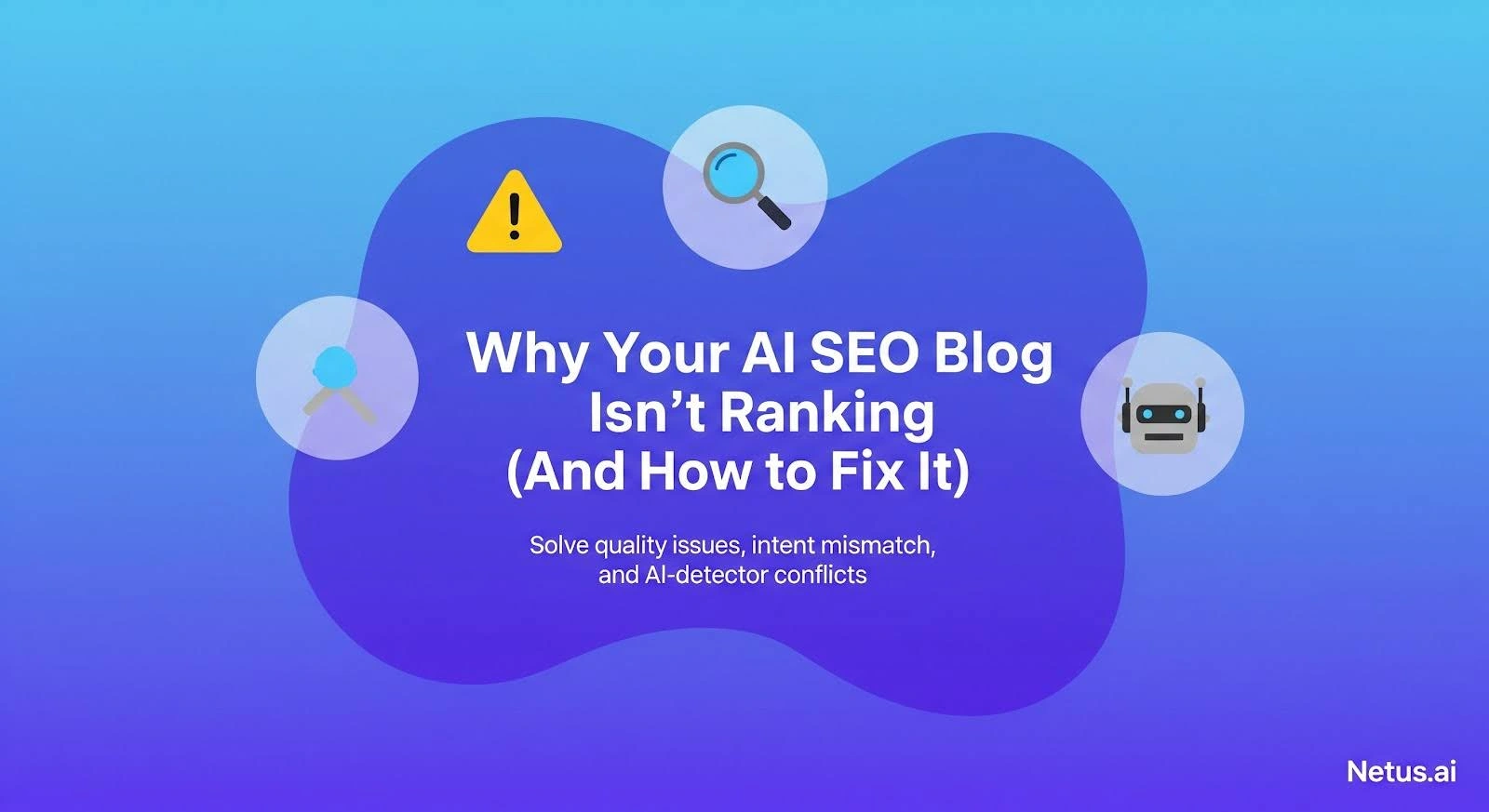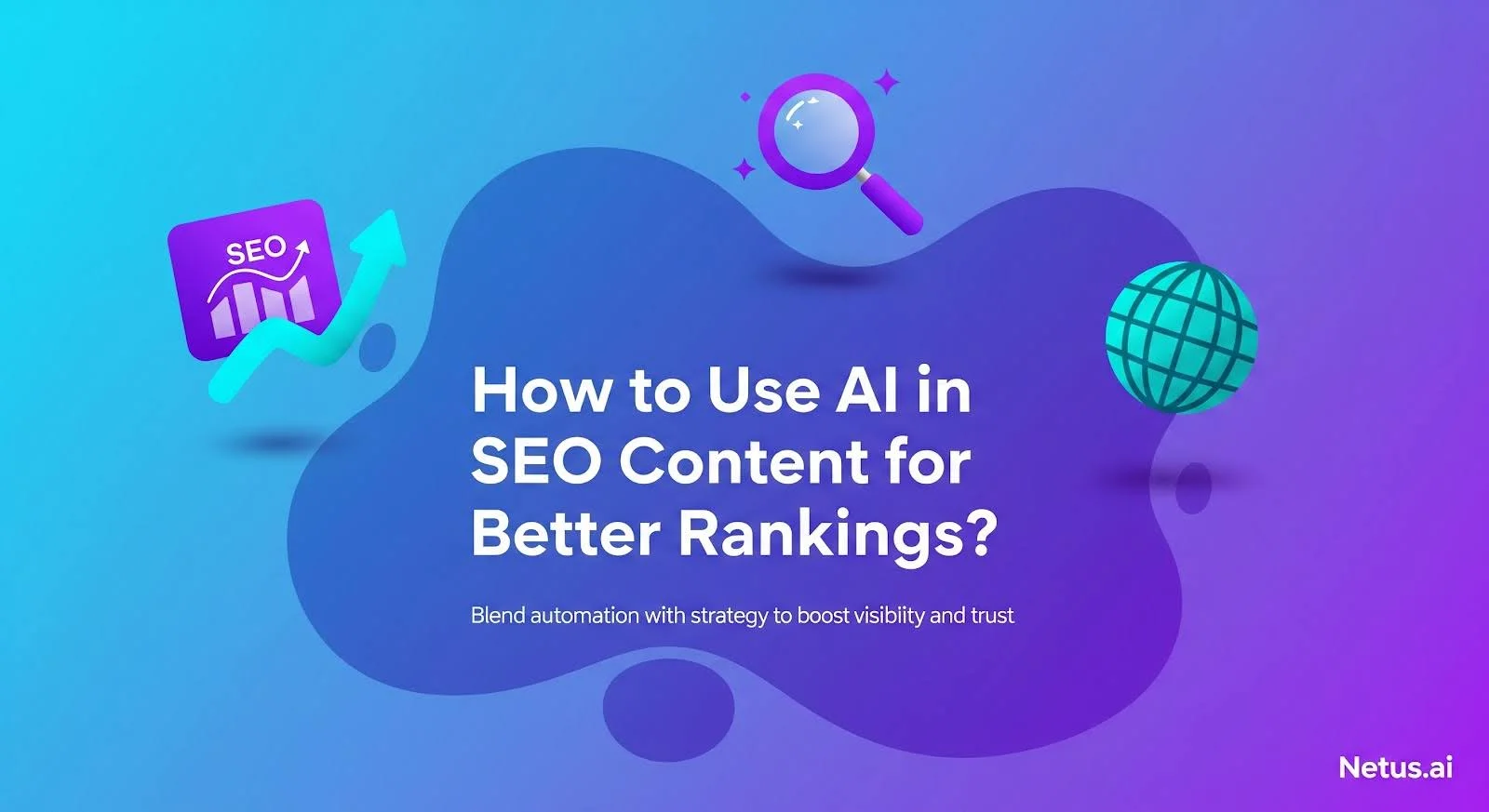We’ve all seen the AI hype and tried it. AI content can be grammatically perfect but often lacks the soul needed to rank effectively.
The belief that AI can instantly generate SEO-optimized content is a marketing myth. The internet is already oversaturated with generic, keyword-stuffed content lacking real value.
So, what’s the secret? How are some people using AI to create content that actually climbs the Google rankings?
Why are most AI generated SEO blogs dead on arrival?
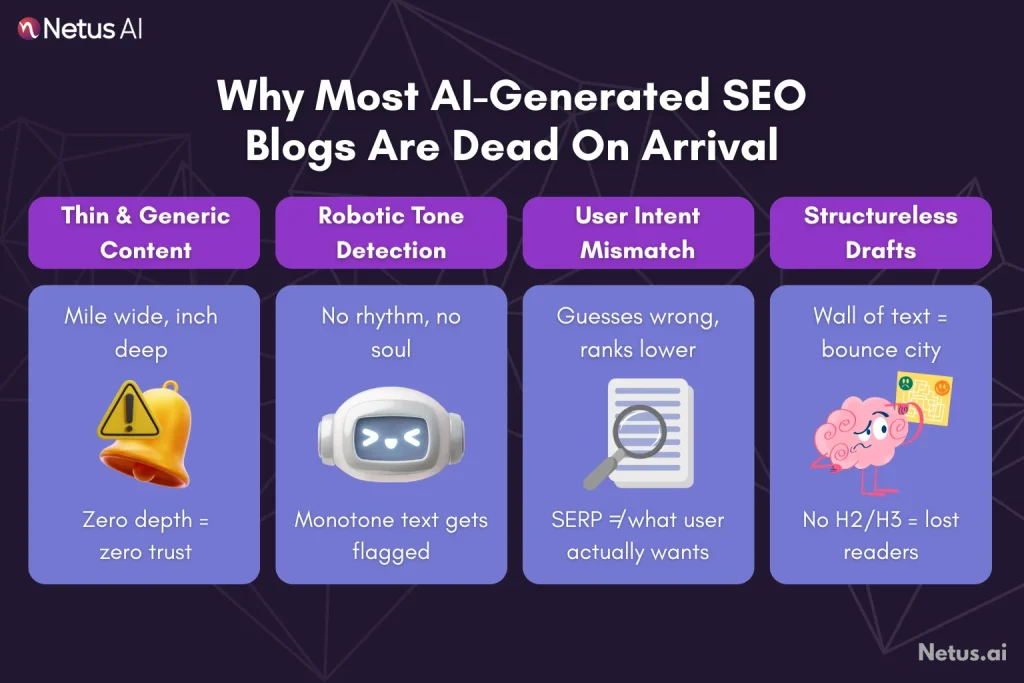
Before we get to the good stuff, let’s perform a quick autopsy on a typical AI blog post. Understanding why they fail is the first step to making them succeed.
1. They're thin, generic and forgettable
AI models, trained on the entire internet, excel at average content. Without specific direction, their output is broad but shallow.
2. They sound like a robot wrote them
You know the sound: same-length sentences, safe vocabulary, no rhythm, punch, or personality. Linguists call this a lack of “burstiness.” Humans write with a natural variation of long, flowing sentences and short, sharp ones.
3. They completely miss the user's intent
AI doesn’t understand user search intent (buy, learn, quick answer), so its guesses are often wrong, a major SEO flaw.
4. They have no real structure
Use clear headings (H2s, H3s) for well-structured blog posts. AI drafts often create “walls of text,” increasing bounce rates and signaling unhelpful content to Google.
The human touch: where the real magic happens
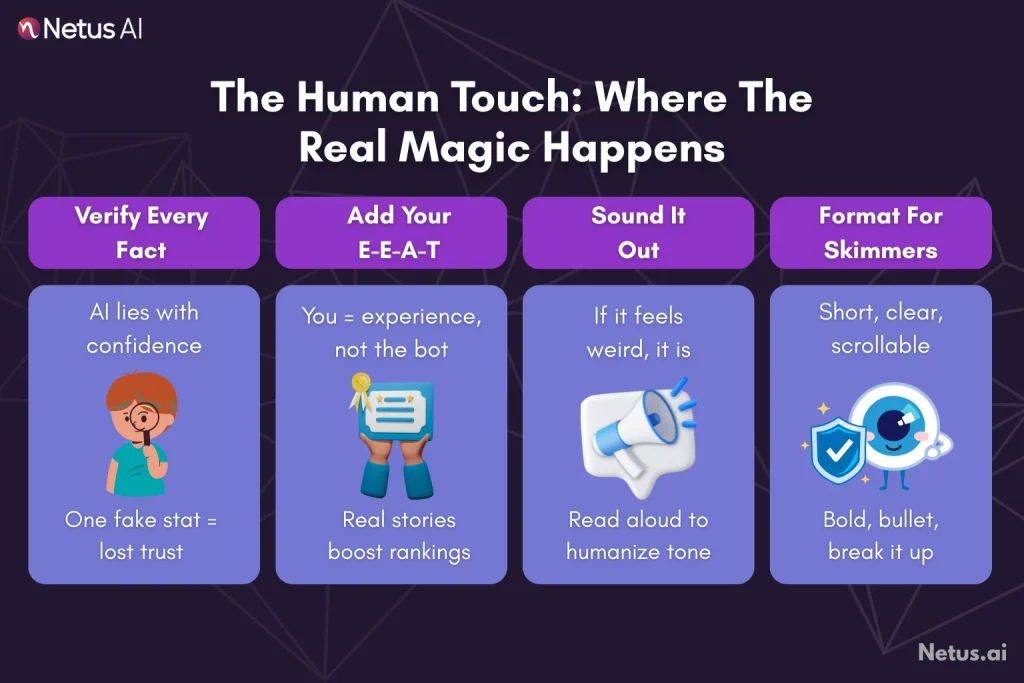
Okay, you’ve used a killer prompt to generate a fantastic draft. Do not hit publish. This is where 90% of people fail.
1. Fact check like a journalist
AI models are notorious for “hallucinating”, making things up with incredible confidence. Always verify AI-generated statistics, dates, or claims from primary sources.
2. Inject your secret sauce (e-e-a-t)
Google’s quality guidelines revolve around Experience, Expertise, Authoritativeness and Trustworthiness. This concept, known as E-E-A-T semrush, is central to modern SEO. An AI has none of these. You do.
- Add Your Experience: Weave in a personal story. “The first time I tried the 16/8 method, I made the mistake of”
- Flex Your Expertise: Add an insight the AI missed. “While most guides recommend X, I’ve found with my clients that Y works much better for beginners. Here’s why”
- Build Authority: Quote other experts. Link out to a university study that backs up your claim.
- Show You’re Trustworthy: Be transparent. Add a disclaimer. Make sure your advice is safe and responsible.
3. Read it out loud
Ensure the text flows naturally when read aloud; if not, rewrite it. Vary sentence lengths and add personality.
4. Format for skimmers, not readers
Let’s be honest, people don’t read online; they skim. Your job is to make your article skimmable.
- Use short paragraphs (2-3 sentences max).
- Use lots of headings and subheadings.
- Use bullet points and numbered lists.
- Bold key phrases to grab the reader’s eye.
The final on-page SEO polish

You’re almost there. This is the final pre-flight check before you launch your content.
- Compelling title tag: Is it under 60 characters and does it make someone want to click?
- Intriguing meta description: does it summarize the article and give a reason to read your post over the others?
- Clean URL: Is it short and sweet (e.g., yourdomain.com/beginners-intermittent-fasting)?
- Image alt text: have you described your images for visually impaired readers and for google’s image search?
- Schema markup: add schema markup (structured data) to help search engines understand content and potentially gain rich snippets.
Your new superpower
AI isn’t a magic bullet for SEO. It’s a force multiplier. It won’t replace your strategic brain, your unique experiences or your authentic voice. It can’t build a relationship with your audience.
But it can eliminate writer’s block. It can do the grunt work of research and drafting in seconds. AI handles 80% of content creation, letting you focus on the 20% requiring human insight.
Stop thinking of AI as an autopilot. Start thinking of it as a co-pilot. You’re still the one flying the plane. But now, you can fly further and faster than ever before.
SEO safe content starts at generation: NetusAI’s SEO article writer
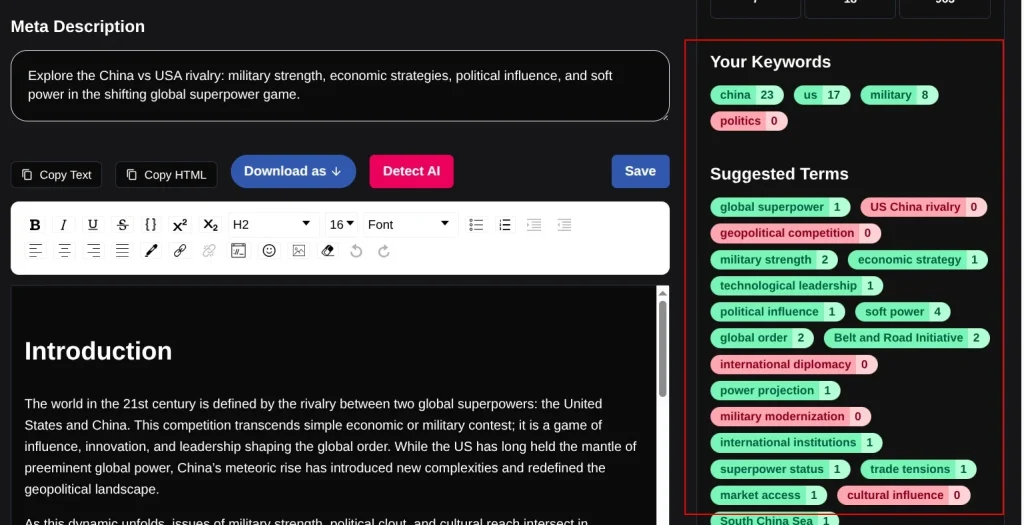
Avoiding stylometry and detection issues shouldn’t begin after content is written, it should start with the writing itself. That’s where NetusAI steps in.
NetusAI’s SEO Article Generator produces optimized, comprehensive blog posts. This sets it apart from generic AI tools that often create stiff, easily detectable content. Unlike generic tools, it goes beyond simple drafting. It:
- Lets you input headlines and targeted SEO keywords
- Supports long-form templates for full blogs
- Auto-generates a structure with Title → Outline → Content
- Works in multiple languages for global teams
Crucially, it integrates with the Netus AI Bypasser + Detector to ensure the output is undetectable.
You can generate, review and rewrite all in one interface without needing third-party tools to patch the gaps. It’s built for marketers, freelancers and bloggers who want their AI content to actually pass as human-written.
NetusAI saves time and rewrites, from idea to full SEO article, without sacrificing trust or quality.
Final Thoughts
Using AI to write blog posts isn’t cheating the system, it’s speeding up your workflow. But speed without structure is useless. The truth is: Google rewards helpful, clear and original content. And that’s not what you get from raw ChatGPT outputs or lazy AI generators.
To rank AI content, guide the AI, edit for clarity, and bypass detection without losing meaning.
That’s where NetusAI steps in:
- Write with structure using the SEO Article Generator
- Humanize your tone with the Paraphraser
- Detect and fix red flags with the AI Bypasser
In short: Use AI. But write like a human. Rank like a pro.
FAQs
No and you shouldn’t. AI helps with structure, topic ideation and drafting. But human editing, optimization and tone tuning are still critical for SEO performance.
Tools like NetusAI’s Paraphraser or AI Bypasser can humanize AI content by altering words, sentence flow, burstiness, and stylometry.
Manually review AI content for search intent, keyword stuffing, and user behavior, even with AI assistance.
To rank, AI content must be high-quality, helpful, and undetectable; Google penalizes low-value, robotic, or spammy content.
NetusAI’s SEO Generator offers detection, rewriting, and humanizing features to create authentic, readable, and SEO-optimized content.
AI, when guided strategically and refined by human input, along with tools like NetusAI, enhances SEO. It achieves this by generating high-quality, helpful, and human-like content that performs well in search rankings.
NetusAI’s SEO Article Generator offers a free trial. You can visit their website for details on “SEO writing AI pricing” and how to sign up for the free trial.
Keyword planners like Ahrefs and Semrush, and SERP analyzers like SurferSEO and Frase. Additionally, NetusAI’s SEO Article Generator and AI Bypasser + Detector are highlighted as comprehensive “SEO writing tools” for generating and optimizing content.
Strategic AI SEO prompts outperform basic ones by defining audience, tone, H2 headings, and related concepts.
AI-generated SEO blogs often fail due to being thin, generic, robotic, missing user intent, and lacking proper structure. AI models are trained on the “average” of the internet and need specific human guidance to produce valuable content.
NetusAI excels in SEO writing, surpassing tools like ChatGPT due to its quality, flag avoidance, and minimal oversight.
Avoiding detection should start at the generation phase. NetusAI’s SEO Article Generator creates optimized, comprehensive content that is less likely to be detected as AI-generated. The Netus AI Bypasser + Detector also helps ensure the output is undetectable.

